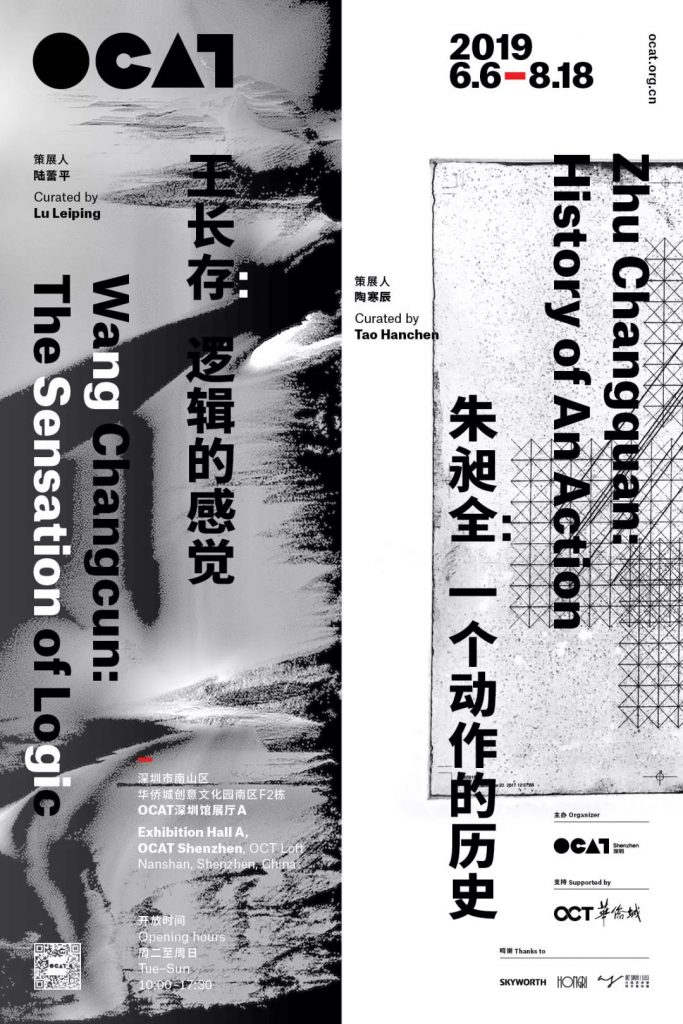「Wang Changcun: The Sensation of Logic」 | 「Zhu Changquan: History of an Action」
Artists: Wang Changcun, Zhu Changquan
Curators: Lu Leiping, Tao Hanchen
Exhibition Duration: 06/06 — 18/08,2019
Venue: Exhibition Hall A, OCAT Shenzhen
“All-factor Image Narrative” marks the central notion of Zhu Changquan’s video works. Everyday customs conditions the general public to incline for certain kinds of visual phenomenon. However, the formation of an event does not necessarily follow a linear progression. Instead, what is often overlooked as useless that is concealed behind its own assumption plays a pivotal role in solving the problem. Zhu Changquan tries to free these “useless things” (all factors) from the myth of conventional experience, so they could be restored to serve the purposes of authentic narration.
Zhu Changquan’s initial exploration on the notion of “All-factor Narrative” can be found in Blow-up (2014) and Transplant (2015). These two works also marked the beginning of his independent artistic practice. Blow-up departs from the artist’s deepest fear, for which Zhu sets a multi-dimensional narrative structure: fear dictates people’s behavior, life, and personality. The fear can also be provoked and blown up at a point in time or by an incident and then brings one into a state of near madness.Transplant reshuffles and rebuilds the logic of language, adopting means similar to mathematical algorithms that deduce narration into an expression without representing any ideologies.
Since 2015, Zhu Changquan’s furthered his practice in video art by expanding on multiple layers of experiments. He collected and produced a large quantity of fragmented video clips that are related to everyday life – for instance, Body without Organs (2015). Using collage, montage, and other narrative means, these raw footages have thereon appeared repeatedly in Zhu Changquan’s works. Head without Brain(2016-2017) draws inspiration from two historical periods (700 years and 30 years) in the progress of Chinese history and addresses the relationship between the physical space that the body occupies and the virtual space information transmits. With the development of the Internet and media technology, the boundary of life expands from reality to virtual reality. Under the state of being mindless, the boundary between these two becomes increasingly ambiguous: as the virtual expands into the parameter of everyday reality, and becomes the tool to verify the truth, it would be closer to it than reality itself. Jump from the Past (2017) further enacts and iterates the aspect of memory from Head without Brain: memory is an enactment and imagination of images and texts. As information that exists eternally, it is grained inour bodies and then conveyed to the world through actions. His most recent video installation, History of an Action (2018) focuses on the issue of incident in addition to continuing to address the notions of memory, reality, virtual reality and etc. With Boundary Post – a conversation unit for time and space invented by the artist, many incidents are dismantled into countless authentic actions, and transformed into tangible still life. The three-dimensional abstract still life became the appearance of the incident closest to the truth.
It’s not difficult to discover that, every work in this exhibition is grounded by its internal and independent logic. However, when we undo the boundary of looking at these works, their embedded clues become visible – the overlapping moving images, whispering subtitles, and the color block montage challenging our common ways of viewing, contribute to the concise narrative structure and solid integrity, as well as the artist’s inquisitions along the progression of his practice. Therefore, the exhibition allows for a relatively open space and exhibition modes for various artistic mediums, in order to facilitate the viewer to visualize the artist’s history of action.
Tao Hanchen
About Artist: Zhu Changquan
(b. 1989, Shandong Province, China) graduated from the ExperimentalImage Studio, School of Inter-media Art, at China Art Academy in 2014. Zhu Changquancurrently lives and works in Hangzhou and Shanghai.
Zhu Changquan engages in artistic activities through analyzing everyday life. He attempts toreveal the rule of daily life based on a variety of potential factors which influence human’s dailybehavior. He believes that the effectiveness of the image roots in its potential power rather thanits general meanings. The potential power enables the viewers to release their accumulatedexperience, and get involved in the giant social machinery more consciously. From ZhuChangquan’s perspective, the development of things never follows a single-linear narrative,thus “All-factor Narrative” marks the central notion of his video works. Zhu Changquan buildsa new narrative relation between intangible image and tangible daily objects by means ofdifferent languages, such as drama, animation, installation, painting, and etc.

